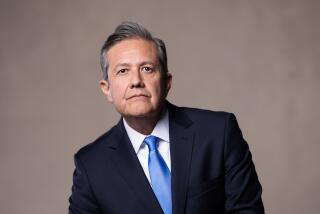New World Vision President Named : Robert A. Seiple, 44, Will Replace Ted W. Engstrom, 70
- Share via
Robert A. Seiple, a college president, former athletic director and Marine Corps captain decorated for combat in Vietnam, has been named the new president of World Vision.
Seiple, 44, will succeed retiring president Ted W. Engstrom, 70, next July 1 in administering the U.S. ministries of the giant Monrovia-based Christian relief, development and evangelism agency. World Vision, which serves about 15 million needy people in 90 nations, has a current annual budget of more than $237 million.
The selection of Seiple is an example of an emerging trend in mainline evangelical circles to seek younger leaders to replace an older generation of executives and church officials.
The Rev. Roberta Hestenes, who chairs World Vision International’s board of directors and headed its search committee for a new president, said the three finalists were in their mid-40s. She said about 60 candidates were considered, including several women.
An Infusion of Energy
“We were looking for someone just coming to the peak of his or her career who would bring energy, a freshness, and a long-term commitment to World Vision’s ministry,” said Hestenes, who is also an associate professor at Fuller Theological Seminary in Pasadena. Engstrom announced Seiple’s selection on Tuesday.
Seiple has been president of Eastern College, a liberal arts school of 1,050 students, and Eastern Baptist Theological Seminary, a 400-student school affiliated with the American Baptist Churches, since 1983. The schools are in St. Davids, Pa., 25 miles west of Philadelphia.
A layman, Seiple was a sales executive for Boise Cascade Corp. in 1969-71 before becoming athletic director at Brown University in Providence, R.I. He was also vice president for development at the school--his alma mater--and was instrumental in raising $182 million for educational programs at Brown in 1979 through 1983.
During his military career from 1966 to 1969, Seiple flew 300 combat missions and received the Vietnamese Campaign Medal with five Battle Stars, a Navy Commendation Award, 28 Air Medals and the Distinguished Flying Cross.
No Major Changes Planned
Seiple said he plans no immediate major changes at World Vision.
He said he will bring “transferable skills” to his new job, including abilities in “fund-raising, complex administration and public speaking.”
Said Engstrom: “Bob Seiple will bring to World Vision the dynamic leadership strength, vision and holistic Christian commitment that have been a hallmark of his accomplishments at Eastern. Seiple is an academician . . . with a strong interest in fund raising, especially among the large corporate structures. I’m very, very pleased.”
Engstrom has served as president of the U.S. division of World Vision since 1980 and was president of both its U.S. and international ministries from 1982 to 1984. In 1984, Tom Houston was named to head World Vision’s international work.
In 1985, the year of intense media publicity about famine in Ethiopia, World Vision’s U.S. income jumped about 30% from the previous year to $231 million, including $164 million in cash donations from individuals and churches, and $67 million in donated goods, most of which were supplied by the U.S. government.
Financial Condition
For the fiscal year ended June 30, 1986, World Vision’s U.S. income climbed to $237 million. But cash gifts dropped $10 million to $145 million while government “in-kind” donations of food and other supplies rose to $92 million, according to World Vision spokesman Kenny Waters. He added that World Vision’s U.S. contributions finance about 60% of the agency’s international work.
This year, Seiple said, World Vision has 133 fewer workers than in 1985, reflecting less need for staff to handle donations pledged by telephone callers and for mail processing.
“An organization dealing with volatile issues such as natural disasters and catastrophes has to be able to expand . . . for an Ethiopian crisis . . . and then contract responsibly” afterward, Seiple said.
Seiple’s only previous connection with World Vision has been a $750,000 grant from the agency to Eastern College to finance an innovative program in economic development.
“We started a master’s in business administration program at the school four years ago to train entrepreneurs and administrators for the inner city and Third World countries,” Seiple said during an interview in Monrovia.
Backbone of Organization
Seiple said World Vision’s overseas economic development, child sponsorship and evangelism programs will continue to form the organization’s backbone, while grants to other agencies involved in U.S. prison ministries and help for the nation’s homeless will also be emphasized.
World Vision was founded in 1951 by evangelist Bob Pierce as a response to the needs of Korean orphans. The Rev. Stanley Mooneyham, the organization’s president from 1969 to 1982, brought global attention to its work, especially among refugee children.
Engstrom, who was World Vision’s executive vice president from 1963 to 1980, said he will continue to serve the agency on a half-time basis beginning in 1988 as well as do outside consulting, speaking and writing.
Seiple and his wife, Margaret Ann, are the parents of three children, Jesse, 10, Amy, 17, and Chris, 18, a student at Stanford University.
More to Read
Sign up for Essential California
The most important California stories and recommendations in your inbox every morning.
You may occasionally receive promotional content from the Los Angeles Times.










